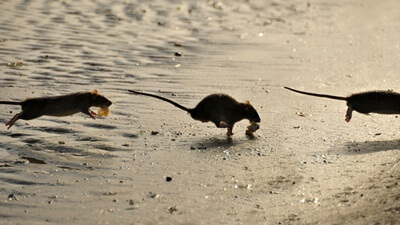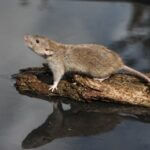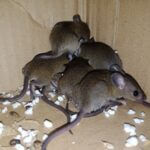Rats are prey animals, so they’ve evolved to have many adaptations that protect them from danger.
They know how to scatter for safety and stay out of sight to aid their survival. They can jump 3 feet into the air, leap 4 feet horizontally, and fall from 50 feet without getting hurt.
When cornered, rats use their sharp incisor teeth and claws to bite and scratch adversaries. They can flee danger at impressive speeds, running to their hiding spots.
They scream, squeal, and produce sounds that scare away predators and warn other rats of danger.
Their hiding areas have several entrances and exit points to confuse the attacker. Rats have highly developed senses that help them sense an enemy from far away.
They typically live in colonies of up to 100 rats to create a formidable defense. Also, they usually live in small areas and master the terrain.
How Do Rats Protect Themselves From Predators?
Rats are prey animals and are vulnerable to attacks from larger animals. Rats have several physical and behavioral adaptations that protect them from predators.
Here’s a breakdown of how rats protect themselves from enemies:
Highly Developed Senses
Rats have poor vision. However, they use their other senses to move around and protect themselves from predators. They have excellent hearing and can detect a predator long before they can even see it. Rats easily determine the direction of predatory sounds and escape to safety.
Likewise, according to the University of Hawaii, rats have superb olfactory systems that can smell predator odors and detect danger swiftly. In particular, Cornell University found that rats have expanded olfactory receptor repertoires containing nearly 2,000 genes.
They can detect odorant molecules from great distances, even at small concentrations. With this superior olfactory system, a rat can smell an approaching predator, flee to safety, or warn other rats of danger.
Behavioral Adaptations
Rats have several behavioral adaptations tailored to scare or confuse potential predators.
They usually congregate in one place and live in colonies of dozens of rats. When many rats are in a single nest, a predator may hesitate to approach them. Living in groups also means more eyes are on the lookout, and the rats can warn each other in case of danger.
Another behavioral adaptation is being nocturnal. Rats are more active at night, and they usually come out in the evening, well after dark, to forage for food. They stay out of sight during the day.
Nonetheless, rats are also adaptable animals and can change their schedule to scavenge for food during the day when necessary. For instance, rats in a nightclub are likelier to come out during the day than at night because it’ll be far quieter and lack activity during this time.
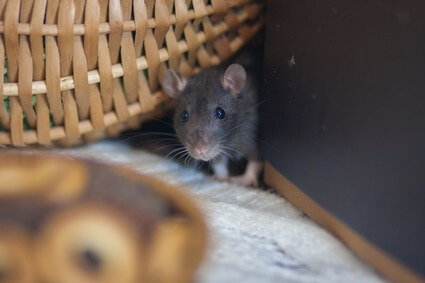
Camouflage
One obvious adaptation that rats use to defend themselves is their color. Depending on their natural habitat, rats come in brown, grey, or black.
A rat’s dark color camouflages it to resemble its surroundings and protect it from potential predators. Rats are also relatively small animals, which helps keep them undetected by their enemies.
Warning Signals
Rats use warning signals such as screaming, squeaking, hissing, and squealing. This is to scare away predators and warn other rats of the lurking danger.
Rats also use visual cues to warn their counterparts of the situation. According to Molecular Pain, rats can respond to danger by reading the pained facial expressions of other rats.
Defensive Abilities
Rats are superb escapists, using their running and hiding skills to confuse and evade predators.
Their cylindrical-shaped bodies also allow them to squeeze through tiny holes and spaces. A rat will turn to its fighting skills when cornered with nowhere to run.
Rats have sharp incisor teeth and claws that they can use to bite and scratch a predator.
How Do Rats Predict Danger?
Thanks to their highly developed senses, rats can spot danger and plan an escape from predators. Even though they have poor eyesight, they rely on their other strong senses to get around and flee.
According to the University of Sydney, rats have a natural defensive behavior towards predatory odors. When a rat detects the presence of an enemy, it’ll perform a risk assessment of the environment before deciding whether to venture out or not. The rat will poke its head out of its hiding spot and scan the area to determine if it is safe to head out.
Rats also use their excellent hearing to detect danger. They can quickly pick up high-pitched, ultrasonic sounds from a great distance. The rat’s hearing range is far better than a cat’s or dog’s, which explains why they often stay out of danger without effort.
What Are The Natural Predators Of Rats?
Rats are prey animals with many natural predators. In the wild, rats expose themselves to predators different from those in human environments.
Wild rats may fall prey to foxes, hawks, and weasels, while rats in human environments are targets for dogs and cats. Here’s a list of a rat’s natural predators.
- Snakes
- Wild cats
- Owls
- Eagles
- Falcons
- Weasels
- Ferrets
- Opossums
- Coyotes
- Dogs
If you have a rat problem, dogs, cats, and ferrets can be beneficial. However, you can only rely on a few dog breeds, such as schnauzers, renowned for their prowess in hunting rodents.
Main Predators of Rats
Wild rats have many natural predators, but their main enemies include:
Barn Owls
Barn owls and other birds of prey are exceptional rat killers.
One main advantage that owls have is their nocturnal design. They usually hunt when rats are most active, searching for food at night.
Owls have excellent night vision, allowing them to see their prey relatively easily in the darkness. They have binocular vision for increased depth perception.
Feral Cats
Unlike most domestic cats, feral cats are excellent rat-catchers.
Stray cats do not rely on human food, so they must fend for themselves by hunting rats, mice, and other small animals.
Feral cats can help reduce rat populations in particular situations but might not effectively deal with infestations if they have other food sources.
Weasels
Weasels are swift and ruthless hunters from the same family as badgers and otters.
What sets them apart from the rest is that they are nocturnal. They hunt at night when rats are most active. Weasels have a strong sense of smell and can track the scent of their prey from a great distance.
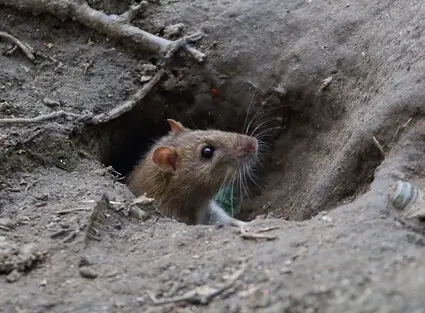
Snakes
Many snake species are renowned for hunting rats and other rodents. These snakes aren’t venomous and often subdue their prey through constriction.
Snakes have an advantage over other animals because they can raid rats in their nests and holes, which other predators cannot easily reach. Snakes also inhabit garages and barns where rats prefer to hide.
Foxes
Urban foxes live in suburbs and cities rather than in the wild. They have several adaptations that enable them to survive without endangering themselves.
Since they have limited food sources, foxes usually hunt rats, mice, chickens, wild birds, and other small animals. Over the years, they have become one of the main rat predators.
Other predators of rats include opossums, hawks, stoats, cats, and dogs. These predatory animals can reduce rat populations in your home area but are not a long-term solution to rat infestations.
How Do Rats Protect Each Other?
Rats are social creatures that prefer to live together in groups for protection and mating.
Each family group has a dominant male who protects the other members from foreign rats. The dominant rat fights intruders with its sharp teeth and claws.
When faced with an external predator, rats use warning signs and alarm calls to alert others of the looming danger. They scream and squeal to urge their counterparts to take cover.
How Do Rats Protect Their Young?
Mother rats protect their young from predators by ensuring their nests are out of reach in dark and deep locations, including crevices and holes in rotting logs and abandoned buildings.
A mother rat will ensure the nest is not easily accessible to protect her offspring. Moreover, she will not allow her young rats to come out until they are about five weeks old.
From hearing to smell and even speed, rats have many ways of defending themselves. This helps keep them alive in a world where most predators target them as food.

